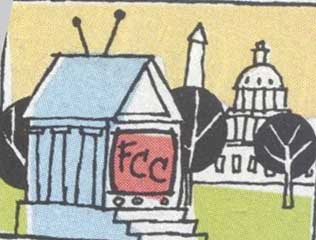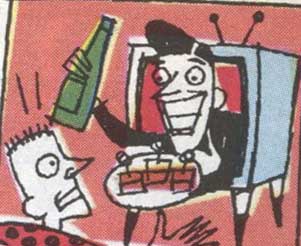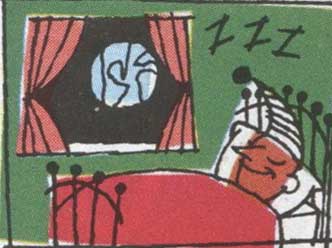
Tomorrow TV
Television Has Brought the World to Our Living Rooms, Changing That World in the Process. Now Our Computers Are Changing Television.

Tune In the future
If you've had it up to here with uninspired, overproduced, poorly acted, and badly written comedies, dramas, commercials, documentaries, game shows, cartoons, talkfests, and newscasts, take heart. The most successful consumer electronics product of the century and the most influential information technology of all time are coming together to create hundreds, even thousands, of potential new products, programs, services, and opportunities. After half a century of analog life, television is about to become a digital medium. Your television is entering the computer age.
Television waves, like radio waves, use a portion of the electromagnetic spectrum, and there's only so much spectrum to go around. A variety of distribution alternatives are now available, all made for the digital world. Fiber optics can carry tens of thousands of digital signals at once—and carry them not only from source to receiver, but also from your receiver back out into the world. Compact discs and laser discs are already being used as video publishing media. Computers increasingly possess TV-like capabilities, just as TVs contain larger and larger amounts of computing power.
The ramifications of that power can only be glimpsed today. Who, 50 years ago, would have predicted the myriad ways television has changed society? Our purpose, here, is to offer a few informed glimpses, imagine a few consequences, and make some qualified guesses.
There's an underlying conceit to our speculation, and that's the idea of interactive television.
Once a television program—or anything—has been digitized, it can easily be manipulated. We're all familiar with the convenience of word processing, the pleasure of interactive computer games, the potential of electronic learning. Add full-motion video and high-quality digitized sound to the equation, and you're on the brink of TV that we control, rather than the other way around.
What exactly does this mean for all of us couch potatoes stretched out in front of the tube? Don't touch that dial—you're about to find out.

Apple of your TV Eye
At Apple Computer, multimedia is where television, film, music, and interactive computer programs come together. A top-of-the-line Macintosh can display any of 16.7 million colors, providing tremendous potential for displaying lifelike pictures on your computer monitor. Link this system with the superb sound of audio CDs, the 54,000 still or moving video images available from a single laser videodisc, and the vast software storage capacity of CD-ROM discs, and you'll soon see why many in the industry think we're on the verge of truly interactive television.
Apple's CEO John Sculley himself set the tone for Apple's vision in Odyssey, his 1987 autobiography. In that book, he described what he called a Knowledge Navigator, "a tool as galvanizing as the printing press."
To make Sculley's dream come true, Apple's multimedia lab is working closely with Lucas-film Games to develop the new visual vocabulary that will join computer graphics with video images. Much as D. W. Griffith had to invent cinematic techniques in his early films because there was no one to teach him, today's multimedia pioneers face the challenge of building an entirely new art form.
Some of the new video tools are truly startling. In one of Lucasfilm's techniques, a HyperCard flip-book animation moves to the edge of the computer screen, disappears, and then continues, as live video, on an adjacent television screen. A Macintosh coordinates the transfer of image from computer screen to TV screen. Apple and Lucasfilm have also collaborated with the Smithsonian Institution and the National Audubon Society to combine new technology with archival film and video.
As early as 1983, Apple acknowledged that we think visually as well as linguistically. With faster processors, better display technologies, and more sophisticated compression techniques, computers are rapidly moving toward full-motion video. By merging the best of video and computer technologies, we may soon see the day when television at last lives up to its potential—as a true window on the world and an instrument for learning about ourselves.

The Blue Tube
Businesses and corporations are turning to television as a training aid to help improve efficiency, increase productivity, and aid employees in acquiring new skills. IBM is already marketing a variety of interactive TV tools and applications aimed at business and institutional needs.
Big Blue's approach to interactive video training began in 1983 with a product called Info-Window, which combines an analog video signal, typically from a videodisc, with a personal computer equipped with a touch-screen monitor. More recently, the technology has evolved into the M-Motion Video Adapter, a system that can take an analog signal from any NTSC (American television), PAL (European television), or other video source, digitize it, and display it either full screen or in a window format on any VGA computer monitor. In effect, M-Motion lets employees watch TV at a workstation while running other computer programs.
"Employers might be a little disappointed to see you watching soaps in the afternoon," says IBM Marketing Manager Peter Blakeney, "but some of our clients require it. We sold a good number of these [systems] to the National Security Agency. They have a requirement that certain staff monitor the news services, CNN, C-Span, and a few other networks to keep as current on late-breaking happenings around the world as the CIA, FBI, or any other agency."
Operators monitor the television signal in a window while the major portion of the screen is occupied by word processing or other more traditional computer activities. If a certain story on the video feed merits more attention, the operator can at any time bring the signal to full screen and increase the volume.
In most applications, however, the video signal will come from a tape or disc rather than from a live TV signal. "There are enormous markets that we see for multimedia," Blakeney says. "There's training: industrial, on the job, and skill transfers. There's education: kindergarten on up. There's merchandising, where we place multimedia kiosks out where the shoppers are and try to compel them to buy, augmenting retail employees."
Another application includes commercial and business presentations. Interactive TV presentations can be as simple as a product presentation at a sales meeting or as complex as a conceptual presentation by an advertising agency to a client.

Commodore's Comeback Console
What better way to sneak computers into unsuspecting homes than by marrying two of the most popular home entertainment devices: the television and the CD player?
That's what Commodore is trying to do with CDTV, an Amiga-based multimedia CD-ROM player designed for home use. While appearances aren't everything, CDTV's sleek black VCR-like cabinet certainly looks more at home next to the stereo than on the computer desk.
"We've taken a Trojan Horse approach by putting computer capabilities into a familiar box; it just becomes a natural expansion of the home entertainment center," says David Rosen, Commodore's director of international marketing.
Rosen believes CDTV will be accepted by consumers who have previously avoided computers. CDTV, he feels, will be seen as an enhanced CD player. Along with computerlike educational and entertainment software, CDTV will also play standard audio CDs and CD+G (CD plus Graphics: audio discs with visuals, computer graphics, or lyric texts encoded on unused tracks). CDTV isn't being marketed as a CD player with a computer inside, but as a CD player that plays a bigger variety of discs.
"Consumers have no problem moving from a single medium to multiple media," Rosen explains. "TVs aren't just passive terminals anymore. In the past few years, consumers have been attaching VCRs, videogames, computers, and laser discs to them; and all these have made TV acceptable as an interactive medium."
CDTV's success will depend upon its software. "Consumers don't care about boxes; they care about [entertainment] programming," says Rosen. Recalling the spreadsheet that essentially created the microcomputer industry, Commodore hopes for a CDTV version of Visicalc, a product so impressive, so unique, that people will buy a CDTV player just to use it.
"It's like MTV and music videos," Rosen says. "Cable TV created a new entertainment genre. No one anticipated it. We don't know what we will be doing with the [CDTV] technology two years from now."

Class Act
The future of computer education is here now, and it's called interactive video. This technology combines an interactive computer program with as much as two hours of video from a single videodisc. Sometimes a CD-ROM player is added to the mix for an additional 650 megabytes of computer-based material.

The Voyager Company, of Santa Monica, California, specializes in laser-disc and interactive multimedia programs. To get a sense of the breadth of Voyager's interests, look at just a few of the company's recent releases: Eadweard Muybridge: Motion Studies, Vienna: The Spirit of a City, Bird Anatomy II, and The National Gallery of Art.
Life Story, developed by Lucas-film, the Smithsonian Institution, and Apple Computer, includes the 1986 BBC drama "Race for the Double Helix" and adds sound bites, video clips, text profiles, computer-generated diagrams, and videotaped interviews with the scientists involved in the search for the structure of DNA. The information in Life Story is indexed through a DNA-like double helix—one strand indicates scenes from the BBC drama while the other leads to supplemental information.
The Teacher's Living World is an interactive multimedia program developed on a Macintosh IIci for the St. Louis Zoo's The Living World exhibit. Teachers can select audio, video, graphic, and text material and save it to VHS videocassette, laser printer, or computer disk, creating their own classroom presentations. Available resources include an entire biology textbook, as much as 140 hours of full-motion color video from a special videodisc jukebox, and prepackaged "multimedia sets" that cover the most popular topics. Teachers can preview, add, delete, or rearrange their selections before recording them to videotape. They can also add their own titles and narration.
Unlike other electronic media, interactive video lets students and teachers set their own pace and actively participate in the selection of material. Attracted by the vast storage capacity of laser discs and CD-ROMs—where a single disc can contain paintings from the world's major museums or all the text from a complete encyclopedia—schools are forging computers and televisions into unique learning tools.

And Now the News
Imagine putting Tom Brokaw on hold in the middle of a story on computer technology and sending your TV out to find more details than a two-minute news story can provide. Accessing databases throughout the world, your TV assembles a package of information that you can peruse at your leisure.
Better yet, how about a "personalized"’ evening newscast? As your TV grows smarter, it will be able to accommodate more and more your particular programming needs. Suppose you're interested in space travel, biotechnology stocks, and the Boston Red Sox, but not at all interested in clothing fashion, movie stars, or food. Your television may soon be able to scan hundreds of news sources around the clock, collecting stories that impinge upon your interests, flagging others that it "thinks" you might be interested in, notifying you of important stories that you "should" know about.


You won't have to constantly reprogram the smart set, as you must with contemporary VCRs; it will learn your preferences and remember them. Very quickly, the TV set comes to "know" your interests and act accordingly on your behalf.
Some of the required technology is already in place. Closed-captioning, for example, may serve a dual purpose. In addition to enabling the hearing-impaired to receive information, those captions may serve as an index to television content. "Search," you might tell your TV, "for every mention of the planet Mars in the past 24 hours." A moment later, the set reports its findings.
Rudimentary experiments with interactive news are in development. Call-in programs have long offered one level of interactivity. Earlier this year CNN experimented with viewer selection of news stories. ABC News has developed interactive videodisc presentations for classroom use. Several large news agencies have experimented with videotex services, delivering wire reports directly to homes.
Tomorrow's evening news will likely be an amalgam of all these services and approaches, delivering deeper and more useful information than Edward R. Murrow could ever have imagined.

The View From The JCC
This much power will doubtless be regulated by the federal government, won't it? Not necessarily.
Since so many of the new computer/television technologies and delivery systems don't use traditional radio frequencies (RF), traditional means of regulating TV broadcasts don't apply.
"You can transmit anything you want to over fiber optic, and we don't care. Fiber is not RF, and it's outside our purview," says John Reed, electronic engineer, Technical Standards Branch, Federal Communications Commission.
It's different with traditional cable transmissions. "Cables radiate RF," Reed says, "so the FCC regulates it. But fiber doesn't radiate—only where it actually interfaces with transmission and reception equipment to convert light to RF energy does the FCC get involved."
In Reed's view, fiber is coming online just in time. "The spectrum's already too crowded," he says. "You're not going to be able to load tens of thousands of new signals onto it. There's only about two megahertz of unallocated spectrum left—and everybody wants it."
Although the FCC isn't the only government agency overseeing the media, Reed sees regulation as a minor issue. Far larger is the question of whether or not the fiber network needed to create interactive TV will ever be put into place.
"Putting in a cable system was expensive," Reed says, "but a fiber system will be even more expensive. It's going to take a lot of capital."
If broadcast television serves as an example, computer TV will also generate a lot of capital. And that should ensure solid investment.

An Interactive Word From Our Sponsors
It may not be long before the commercials on your TV appear because you are female, make $50,000, live in New Jersey, and have bought an airline ticket within the last three months. The marriage of computers and television enables advertisers to target a specific audience and to deliver very specific information.
Many of the tools and techniques of interactive television are being developed on existing telecommunications services, and some online services already carry advertising. Ads on Prodigy, for example, are tied to the gender and age of the user, as well as to the editorial content of the service.
If, for example, you spend time in Prodigy's food and wine area, you will be shown gourmet food ads. If that "leader ad" piques your interest, you can elect to see more information. According to Steve Hein, program manager of communications with Prodigy Services, the ad package immediately fills one viewer need: instant gratification. Another advantage of the self-selective ad package is that it is nonintrusive—only interested viewers receive the extended ads.

Sign-off
Our time's up already? But we haven't even scratched the surface! Hardly a glance at interactive TV entertainment, barely a mention of the role the phone companies may play in all of this, not even a nod at the global implications.
And there are questions yet unraised. Where do the networks fit into this brave new picture tube? What creative video tools will we have in our homes? How far can all of this go?
The answers to these questions?
Stay tuned.
Senior Editor Keith Ferrell coordinated our PC-TV connection coverage. Staff members Denny Atkin, David English, Tom Netsel, and Liz Casev worked the remote control.